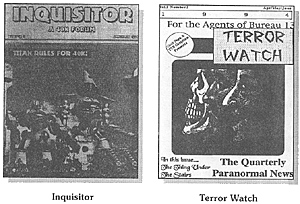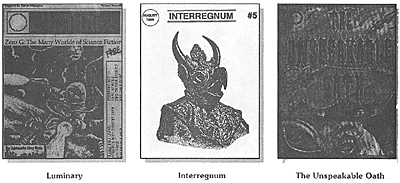There are many ways the fanzine world is reshaping itself right now. My mail is filled to overflowing with talk of a small press federation, several fanzines with a single massive booth at a major con, a small press convention, regular online small press "town meetings," and more.
Almost none of the editors argue with one another, and everyone is aggressive and disciplined. In point of fact, it's the small press editor who has proven he (or she) can conceptualize something and then make it work. So why does nothing substantial occur? Eagles don't fight among themselves, but neither do they fly in flocks.
The costs to enter small press are dropping and the quality is skyrocketing. The voices of small press are echoing the same sentiments, and the editors are beginning to help one another. Could something bigger be far behind?
 Inquisitor
Inquisitor
Publisher: Tim DuPertuis
Editor: Tim DuPertuis
Frequency: Quarterly
Among fanzines, Inquisitor stands out as one of the most visually appealing. Each issue of this thin, black-and-white "forum for Warhammer 40K players" includes many grayscale photos of models, a few articles, and pages of army lists.
Not only are the photos among the best in zinedom, but the print quality is equally good. The strong covers make it a durable play aid. Since Inquisitor covers the tactile world of tabletop gaming, I figure a focus on the visual aspect is to be expected.
While some of the articles are optional house rules (piled on top of the game's already extensive rulebase), some are rules clarifications, including questions about WH 40K. Most of the answers are by Games Workshop staff. Inquisitor also discusses supplies, model scales, con survival techniques, and overviews of miniatures and GW books. There are frequent references to articles in White Dwarf and comments about miniature prices (a sore spot among miniatures gamers).
Inquisitor is an 8.5- by 11- fanzine for Warhammer 40K players and can be contacted at: Inquisitor, PO Box 14485, Santa Rosa, CA 95402-6485.
Terror Watch
Publisher: Chuck Payne / TTS Graphics
Editor: Chuck Payne
Frequency: Quarterly
Years ago I played Bureau 13: Stalking the Night Fantastic and found it memorable, in part due to a creative GM and in part due to the game's approach. Bureau 13 is a covert agency that secretly tracks down and destroys supernatural beings (like the guys who suppress Mulder's cases in the X-Files). Now Terror Watch, the fanzine "For the Agents of Bureau 13" has me interested again.
A slim, comb-bound 8.5" by 11.5-zine, Terror Watch presents articles on the investigations of Bureau 13 agents. The article Booklore & More delved into fiction in search of threads for B13 stories, and another article described Ash from the movie Army of Darkness. (Of course, he had the Fencing skill with his Chainsaw.) Other articles discussed what kind of ammo to use on dinosaurs, how to conduct covert missions without looking like a suit-and-sunglasses FBI agent, and an adventure with a troll under the back stairs of a suburban house.
Terror Watch has gotten off to a good start. The articles are already good, but I hope they get a chance to increase the page count. Contact them at: Terror Watch, 145-B S. McDonugh St., Decatur, GA 30030.
 Luminary
Luminary
Publisher: Quintessential Mercy Studio
Editon Kevin Graeme
Frequency: Quarterly
Luminary is a magazine climbing out of the range of small press with a production run of 5,000. It's more of an avant-garde fanzine - what else would you call a zine with a tagline like "Perspectives Beyond the Role-playing Paradigm?"
Published by the new game company Quintessential Mercy Studio (a William Spencer-Hale and Dave Newton project), Luminary mixes philosophical discus- sions with moody art that involves lots of skulls. There were several editorials by editors, writers, and artists in the last issue.
A magazine for mature role-players, Luminary covers the broad topics of science fiction, fantasy, and horror in the forms of movies, fiction, and games. Mixed in are cartoons and discussions of anime and miniatures. They review a few games each issue and interview professional writers. There's also a lot of fiction, which many magazine readers beg for.
To their credit, Luminary has one of the highest bang-for-your-buck ratios among fanzines, with a high page count and a relatively low cost. This "magazine which embraces the fundamental power of human imagination and creativity" can be reached at: Luminary, 162 Viking Court #4, Athens, GA 30604.
Interregnum
Publisher: Peter Maranci
Editor: Peter Maranci
Frequency: Monthly
It took the longest to overview Interregnum because it's an APA zine, meaning it's huge. Good thing I took my time, because some of it is excellent. IR was originally intended as a temporary project, but developed its own stable of members and now comes out monthly.
Even though most of the members communicate via the Internet, IR does not exhibit the confrontational attitude so common there. Instead, it has lucid, intellectual writing. Some of the articles are astute, insightfid views into role-playing. I chuckle reading some of their opinions on science fiction TV shows. I read some of the fiction, which I normally avoid in game zines. (What's more, I enjoyed it.)
The down side of IR is the same as with all APAs: they use lots of abbreviations (like "RAEBNC"), some authors write stream-of-consciousness, and there is almost no art. Most of these are minimal complaints, though, and to offset them, IR has superb layouts and smart articles. For a sample copy, write to: Peter Maranci, 81 Washington St. #2, Maiden, MA 02148.
The Unspeakable Oath
Publisher: Pagan Publishing
Editor: John Tynes
Frequency: Quarterly
The Unspeakable Oath is one of the very coolest magazines around, and I seldom use the word "cool." Rarely have I heard its readers complain, and having read it, neither can I. TUO is published by the friendly folks at Pagan Publishing, who also produce adventures for Chaosium's Call of Cthulh'u. Based on what my CoC-playing friends have said, Pagan supplements are amazingly good. I've read the adventure Devil's Children, and it was great. The magazine is equally good.
Mere pages into it, I found inspiration for my own fledgling horror campaign. Not only do articles provide fictional NPCs and plots, but more frightening, some describe real world events and books that Gatekeepers can use in their Cthulhu games. Such books aren't tabloids but real tomes written in unknown languages. This creepy mixture of fiction and nonfiction helps build the Cthulhu Mythos.
TUO's cover and interior art are rendered by well-known artists like Anson Maddocks and Jesper Myrfors.
I'm not sure if it's technically small press, but TUO can't have a readership above a few thousand. Send your subscriptions immediately to: The Unspeak- able Oath, 403A N. 8th St., Columbia, MO 65201.
Back to Shadis #17 Table of Contents
Back to Shadis List of Issues
Back to MagWeb Master List of Magazines
© Copyright 1995 by Alderac Entertainment Group
This article appears in MagWeb (Magazine Web) on the Internet World Wide Web.
Other military history articles and gaming articles are available at http://www.magweb.com